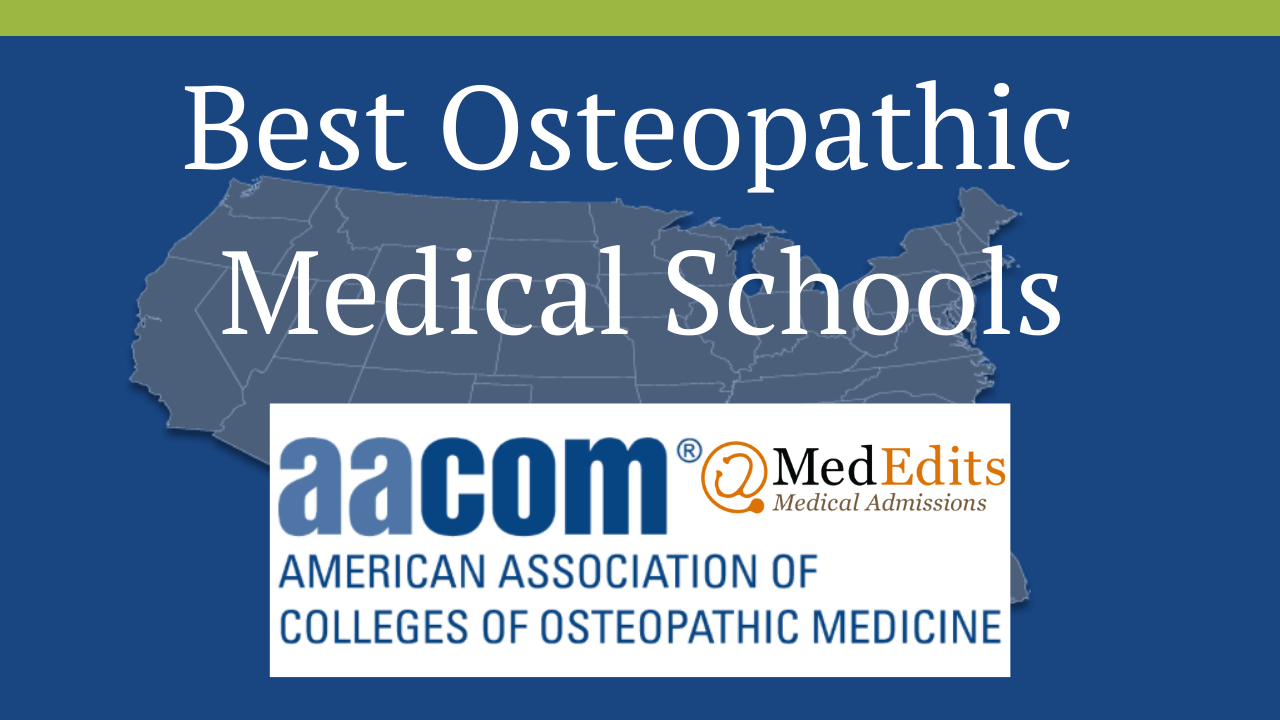
A large number of medical school applicants apply to both allopathic (MD) and osteopathic (DO) medical schools. If you’re passionate about caring for patients but want to go a different route, an osteopathic medical school may be right for you.
A branch of medicine focused on the way different bodily systems work together, osteopathic medicine involves assessing lifestyle and environmental factors while also considering traditional approaches like medicine and surgery. The goal of this more holistic approach is to help the body heal itself while preventing future illness.
It’s important to know that most osteopathic medical school graduates go on to become primary care physicians. Moreover, a large number of DOs (doctors of osteopathic medicine) go on to work as general practitioners in rural parts of the country, though some do pursue other specialities in a variety of locations.
As a DO, you can expect to treat a wide range of problems, including asthma, migraines, sinus disorders, and muscular and joint issues. Keep reading to learn more about osteopathic medical schools and discover whether they might be the right choice for your future goals.
MD Versus DO Medical Schools
It’s important to note that DO programs have lower acceptance rates than allopathic schools. While the standards aren’t necessarily higher than at other medical schools — in fact, student statistics at osteopathic schools tend to be slightly lower — there are currently only 37 accredited colleges of osteopathic medicine in the nation. As a result, competition is intense at top schools.
Although DO schools often admit students with lower GPAs — 3.47 compared to 3.72 in MD programs — these institutions still enjoy a high ranking when compared to traditional medical schools. In fact, 13 of the 37 DO schools appear on U.S. News & World Report’s list of the best medical schools based on their research reputation.
Related Article: DO vs MD: What are the differences?
| School Name | Average MCAT | Average GPA | Average BCPM GPA | Acceptance Rate |
|---|---|---|---|---|
| Alabama College of Osteopathic Medicine | 501 | 3.4 | 3.3 | 10% |
| Arizona College of Osteopathic Medicineof Midwestern University | 508 | 3.54 | 3.48 | NA |
| Arkansas College of Osteopathic Medicine | 498 | 3.46 | NA | 25% |
| A.T. Still University of Health SciencesKirksville College of Osteopathic Medicine | 503 | 3.61 | 3.53 | NA |
| A.T. Still University of Health SciencesSchool of Osteopathic Medicine in Arizona | 504 | 3.48 | 3.37 | NA |
| Burrell College of Osteopathic Medicineat New Mexico State University | NA | NA | NA | NA |
| California Health Sciences University College of Osteopathic Medicine | NEW SCHOOL | NEW SCHOOL | NEW SCHOOL | NEW SCHOOL |
| Campbell University Jerry M. Wallace School of Osteopathic Medicine | 503 | 3.5 | 3.58 | NA |
| Chicago College of Osteopathic Medicineof Midwestern University | 503 | 3.67 | 3.61 | NA |
| Des Moines UniversityCollege of Osteopathic Medicine | 506 | 3.63 | NA | 16% |
| Georgia Campus: Philadelphia College of Osteopathic Medicine | 503 | NA | NA | 12% |
| Idaho College of Osteopathic Medicine | 503 | 3.45 | 3.4 | NA |
| Kansas City University of Medicine and BiosciencesCollege of Osteopathic Medicine | NA | NA | NA | NA |
| Lake Erie College of Osteopathic Medicine | 502 | 3.56 | NA | 8% |
| Lake Erie College of Osteopathic MedicineBradenton Campus | NA | NA | NA | NA |
| Liberty University College of Osteopathic Medicine | NA | NA | NA | NA |
| Lincoln Memorial UniversityDeBusk College of Osteopathic Medicine | 499 | 3.5 | NA | 9% |
| Marian University College of Osteopathic Medicine | 504 | 3.6 | NA | 16% |
| Michigan State UniversityCollege of Osteopathic Medicine | NA | NA | NA | NA |
| New York Institute of TechnologyCollege of Osteopathic Medicine | 504 | 3.6 | NA | NA |
| Nova Southeastern University | 504 | 3.58 | NA | 9% |
| Ohio University Heritage College of Osteopathic Medicine | 502.43 | 3.64 | 3.58 | NA |
| Oklahoma State University Center for Health SciencesCollege of Osteopathic Medicine | Minimum MCAT = 492 | NA | NA | NA |
| Pacific Northwest University of Health SciencesCollege of Osteopathic Medicine | 502 | 3.43 | 3.35 | 6% |
| Philadelphia College of Osteopathic Medicine | 504 | NA | NA | 9% |
| Rocky Vista University College of Osteopathic Medicine Colorado | 505 | 3.6 | 3.5 | 3% |
| Rocky Vista University College of Osteopathic Medicine Colorado | 506 | 3.6 | NA | NA |
| Rowan University School of Osteopathic Medicine | 503 | 3.64 | NA | 7% |
| Touro College of Osteopathic Medicine - New York | 503 | 3.4 | NA | 10% |
| Touro University - CaliforniaTouro University College of Osteopathic Medicine | 508 | 3.51 | 3.45 | 8% |
| Touro University - NevadaTouro University Nevada College of Osteopathic Medicine | NA | NA | NA | NA |
| University of the Incarnate WordSchool of Osteopathic Medicine | 501 | 3.52 | 3.44 | NA |
| University of New EnglandCollege of Osteopathic Medicine | 504 | 3.57 | NA | 10% |
| University of North Texas Health Science Center at Fort WorthTexas College of Osteopathic Medicine | 505 | 3.63 | NA | 12% |
| University of Pikeville - Kentucky College of Osteopathic Medicine | 499 | 3.54 | NA | 8% |
| Edward Via College of Osteopathic Medicine - Virginia | 499 | 3.6 | NA | 12% |
| Edward Via College of Osteopathic Medicine - Auburn | 499 | 3.6 | NA | 12% |
| Edward Via College of Osteopathic Medicine - Carolinas | 499 | 3.6 | NA | 12% |
| West Virginia School of Osteopathic Medicine | 498 | 3.5 | NA | 8% |
| Western University of Health SciencesCollege of Osteopathic Medicine of the Pacific | 506 | 3.63 | NA | 7% |
| William Carey University College of Osteopathic Medicine | 500 | 3.4 | NA | NA |
What You Need to Get into the Best Osteopathic Medical Schools
With so few osteopathic medical schools across the U.S., students who hope to become DOs need to find ways of standing out from the pack. Here are some key aspects to consider if you want to ensure your application packet makes the right impression on admissions committees:
Average GPA and MCAT Scores for Osteopathic Medical School
Academic qualifications play a key role in DO school admissions. While there’s no required major for aspiring osteopaths, most applicants earned a bachelor’s in life sciences. Other popular majors include social sciences, physical sciences, and arts and humanities. Although the average cumulative GPA was 3.54 for DO school matriculants, students had a slightly higher non-science GPA at 3.59.
MCAT scores also play a vital role in DO program admissions. The mean MCAT score for osteopathic medical school matriculants was 504 according to the most recent published data.
Extracurriculars
While academics are important, the most competitive DO school applicants also boast an impressive extracurricular profile. As is the case with MD programs, DOs should look for opportunities to showcase their talent for leadership and research. When in doubt, choose quality over quantity and focus on a handful of activities about which you’re truly passionate.
Because spots are limited at top schools, students need to find ways of demonstrating their interest in osteopathic medicine. One of the best ways to show your interest in the field is to shadow a current osteopathic doctor. Institutions also want to know that students excel at working with patients, so it’s a good idea to seek out opportunities that allow for direct patient interaction.
Additionally, students can convey their interest in holistic medicine by volunteering in their community. Because DOs work with patients to develop healthier lifestyles, applicants may want to donate their time teaching nutrition courses or seminars. The goal is to show that you’re truly devoted to the field and not just seeking an easier route to a medical degree.
Passionate Medical School Personal Statement
Whether you’re targeting osteopathic or allopathic medical schools, the programs will want to know that you’re truly passionate about your chosen career. While you can convey a great deal with your grades and extracurriculars, the personal statement is one of the best opportunities to convey both your love of the field and your goals for the future. To that end, you should ensure your essay reveals the following:
- Why you want to pursue an osteopathic medical degree
- What experiences helped show you that the field was right for you
- How you know you’ll be a successful DO
While many students use the same medical school personal statement for both MD and DO applications, some opt to compose distinctive personal statements for each. After all, osteopathic schools are used to students applying because they think a DO program is an easier path to becoming a physician. Although it’s fine to apply to both types of schools, osteopathic institutions are looking for students with particular qualities and interests related to holistic medicine. Take time to compose a specific and detailed personal statement revealing why this branch of medicine is right for you.
DO Letter of Recommendation
Personal statements are vital, but you also need people willing to attest to your talents and abilities. If you want to increase your odds of acceptance at an osteopathic medical school, be sure to get a letter of recommendation from a current DO. Not only does this show schools you have a deep interest in the field, but it also indicates an understanding of what daily life as an osteopath entails.
If you don’t currently know an osteopathic doctor, you may still be able to secure a recommendation letter. Start by asking your family doctor if they are or know a DO. If they don’t have a recommendation for you, consider searching the DO online directory to find a physician in your area. You may be able to shadow them for a period of time until they feel comfortable writing you a letter. As a bonus, this experience will help you decide if you truly want to be an osteopathic doctor or if an MD program might better suit your needs. The end result is that you’ll apply to medical schools feeling confident of your choice of speciality.
/about_mega.jpg)
Jessica Freedman MD
JESSICA FREEDMAN, M.D., a former medical school and residency admissions officer at the Icahn School of Medicine at Mount Sinai, is the founder and chair of MedEdits Medical Admissions and author of three top-selling books about the medical admissions process that you can find on Amazon.

1 min read
Premed Professional Competencies: What medical school admissions committees are really seeking
Premed Professional Competencies: What medical school admissions committees are really seeking Medical school admissions committees and educators...
/about_mega.jpg?width=500&height=500&name=about_mega.jpg)

